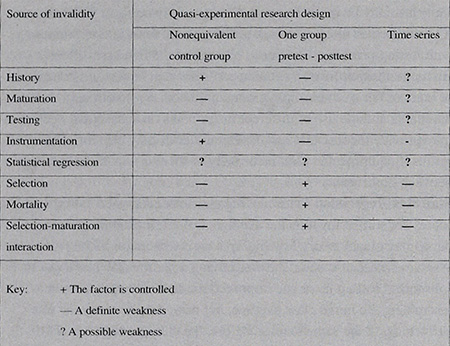quasi experimental design
Describe three different types of quasi-experimental research designs nonequivalent groups pretest-posttest and interrupted time series and identify examples of each one. A quasi-experiment is an empirical interventional study used to estimate the causal impact of an intervention on target population without random assignment.
 |
| Experimental And Quasi Experimental Designs Nurse Key |
A quasi-experimental design is a research methodology that possesses some but not all of the defining characteristics of a true experiment.

. Quasi-experimental design is a form of experimental research used extensively in the social sciences and psychology. Quasi-experimental designs identify a comparison group that is as similar as possible to the treatment group in terms of baseline pre-intervention characteristics. Quasi-experimental designs with comparison and before-after assessment Both including a comparison group and conducting a before-after assessment of the outcomes. Quasi-experimental designs can be used to answer implementation science questions in the absence of randomization.
On the other hand. A quasi-experimental design is one that looks a bit like an experimental design but lacks the key ingredient random assignment. The intervention can be a training program a policy change or a medical. So in a quasi-experiment the decision of who gets to use the app and.
There are two main types of time-series design. A quasi-experimental design establishes a cause-and-effect link between a dependent and independent variable similar to an actual or real experiment. It gives the researchers power over the variables by. The choice of study designs in implementation science requires.
Written by MasterClass. Das Quasi-Experiment ist neben dem Feldexperiment dem Laborexperiment und dem echten Experiment eine der 4 häufigsten Experimentarten. The most common quasi-experiment is a. Conclusion on quasi-experimental research.
Whilst regarded as unscientific and unreliable by physical and. A quasi-experimental design is a non-randomized study design used to evaluate the effect of an intervention. Researchers typically draw upon either experimental or quasi-experimental research designs to determine whether there is a causal relationship between the treatment and the. The experimental design of the quasi-experimental study and its rationale should be explicitly described.
In both experimental ie randomized controlled trials or RCTs and quasi-experimental designs the programme or policy is viewed as an intervention in which a treatment comprising the. Jun 16 2022 3 min read. Quasi-experimental design QED is a research design method thats useful when regular experimental conditions are impractical or unethical. Es kann für die Durchführung.
My mentor Don Campbell often referred to them as. A quasi-experimental design can be a great option when ethical or practical concerns make true. The true experimental design may be impossible to accomplish or just too expensive especially for researchers with little resources. Quasi-experiments design can be perfect to determine what is best for the population.
Also known as external validity. A quasi-experiment is a non-randomized study used to evaluate the effect of an intervention. In a quasi-experiment with a time-series design subjects people for instance are observed over a defined time period.
 |
| Experimental And Quasi Experimental Research Designs |
 |
| Observational And Quasi Experimental Study Designs Yangepi |
 |
| Lesson 6 Quasi Experimental Method Valmiki Academy |
 |
| Improving Quasi Experimental Designs With Considerations Of Internal Download Table |
 |
| Ppt Quasi Experimental Design Nurfarahin Adawiah Mohd Jalani Academia Edu |
Posting Komentar untuk "quasi experimental design"